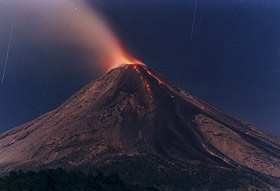 |
 |
 |
 News Around the Republic of Mexico | May 2005 News Around the Republic of Mexico | May 2005  
Mexico's Volcano Of Fire In Colima State Spouts Ash, Hot Rock In Major Eruption
 Mark Stevenson - Associated Press Mark Stevenson - Associated Press


| | Vulcanologists consider the Colima volcano to be one of the most active and potentially the most destructive of the volcanoes in Mexico. |
Colima – A major eruption shook the Volcano of Fire in the western state of Colima Monday, sending a pyroclastic flow of burning gas and rocks fragments more than 2.5 miles (4 kms) down the slopes and sending clouds of ash two miles (3 kms) into the air.

No injuries or damages were reported in the uninhabited areas near the volcano's summit – the nearest settlement is about twice that distance from the peak – but experts called it the biggest explosion in more than a decade at the Volcano of Fire.

"It was the strongest explosion we have seen since 1991," said Tonatiuh Dominguez, a seismologist at the volcano observation station operated by the University of Colima.

"This was a cloud of burning material that traveled down the slope at basically ground level," Dominguez said, warning that the peak "is still in an explosive stage."

Individual chunks of rock were blown as far as 2.5 miles (4 kms) to the west, while the pyroclastic flow mainly streamed down the eastern flanks, according to a statement by the observation station.

Vulcanologists consider the Colima volcano to be one of the most active and potentially the most destructive of the volcanoes in Mexico.

It has erupted violently dozens of times since its first recorded eruption in 1560.

Monday's eruption occurred just before sunset; the ash cloud was blown by the wind toward the west, away from the most heavily populated areas.

The eruption at the 12,533-foot (3,820-meter) volcano located 430 miles (690 kms) northwest of Mexico City, was considered larger than one in 1999 but smaller than a huge 1913 blast.

The 1913 explosion created a crater 1,650 feet deep, blasted fast-moving flows of hot ash down the volcano's slopes and rained ash on Guadalajara, 75 miles (120 kms) to the north. | 
 | |
 |



